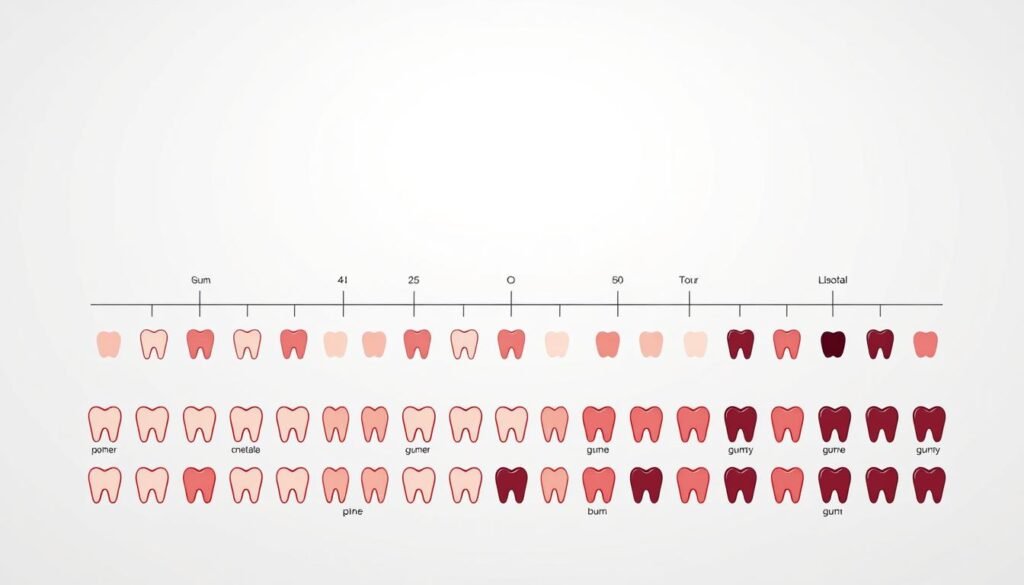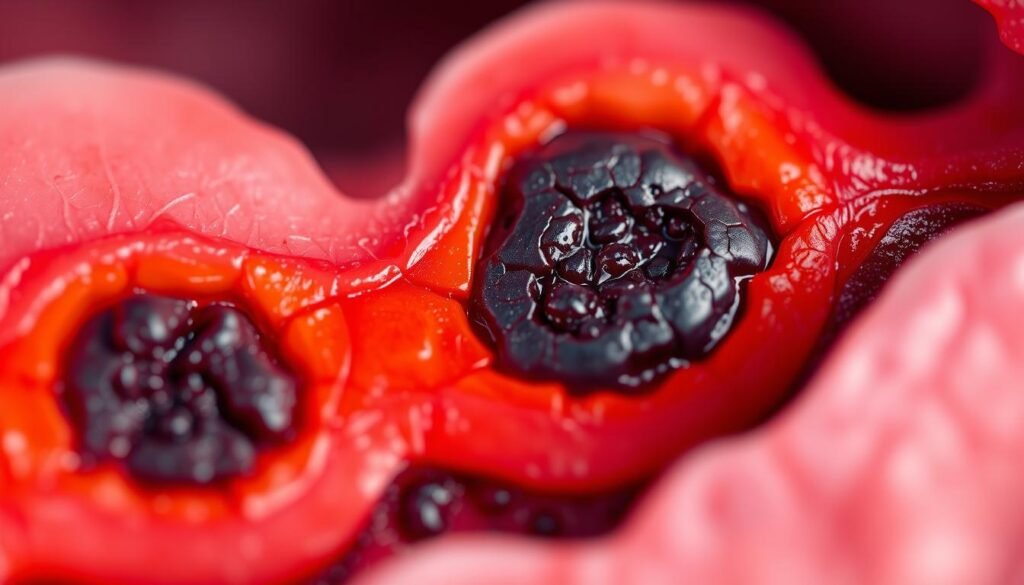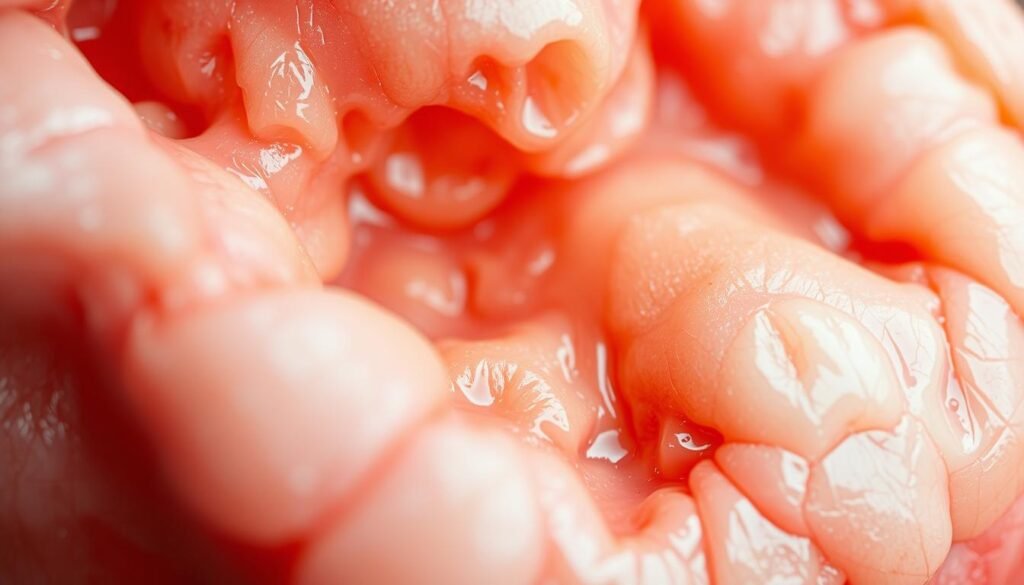What if the color of your gums reveals more about your health than you think? While many assume pink is the only “normal” shade, natural pigmentation varies widely. For some, darker hues are simply genetic – a harmless trait passed down through families. Others might notice changes linked to habits or underlying conditions.
Medical experts confirm that melanin-rich tissue often appears brown or charcoal-toned in certain individuals. This doesn’t automatically signal trouble. However, sudden shifts in color – especially when paired with discomfort – could point to issues needing attention. Our guide explores both scenarios to help you distinguish between harmless traits and warning signs.
You’ll discover how factors like oral hygiene, medications, or smoking influence gum appearance. We’ll also break down when to consult a dentist versus when to simply embrace your unique smile. For those curious about common causes and treatments, we’ve compiled actionable insights backed by dental research.
Key Takeaways
- Natural gum color ranges from light pink to deep brown based on melanin levels
- Sudden darkening may indicate oral health concerns requiring professional evaluation
- Smoking and certain medications can temporarily alter tissue appearance
- Daily brushing/flossing helps maintain overall oral wellness
- Genetic pigmentation requires no treatment unless desired for cosmetic reasons
Rest assured, this article meets strict editorial standards while delivering clear, trustworthy information. Let’s dive into what your gums might be telling you – and how to respond wisely.
Introduction to Gum Health and Black Gums
Your mouth’s color palette holds clues to your wellness. While most focus on teeth, the tissue surrounding them plays an equally vital role. Firm, textured gums act as protective barriers against bacteria. When this defense weakens, your whole body feels the impact.

Setting the Context for Oral Health
Oral hygiene means more than just brushing – it’s a daily defense strategy. Good oral hygiene includes flossing, antibacterial rinses, and avoiding sugary snacks. Poor habits allow plaque to harden into tartar, irritating delicate tissues.
Consider these factors influencing gum appearance:
| Factor | Impact | Duration |
|---|---|---|
| Genetics | Natural pigmentation | Lifelong |
| Oral Hygiene | Prevents inflammation | Daily |
| Lifestyle | Tobacco stains | Reversible |
| Medical Conditions | Disease markers | Varies |
The Importance of Understanding Gum Color
Shades ranging from coral pink to deep brown often reflect melanin levels. Sudden dark patches or streaks, however, might signal underlying issues. A dentist can differentiate harmless traits from worrisome changes during routine exams.
Three key reasons to monitor tissue hues:
- Early detection of infections
- Identification of medication side effects
- Tracking healing progress post-treatment
Upcoming sections explore both natural variations and warning signs, plus practical solutions for maintaining vibrant oral health.
Understanding Oral Pigmentation and Melanin
Melanin isn’t just for skin – it paints your smile’s canvas too. This natural pigment forms in specialized cells called melanocytes, which exist in oral tissue. While most associate it with suntans or freckles, melanin also determines whether your gums appear ivory-pink or espresso-brown.

How Melanin Influences Gum Color
Melanocytes work like tiny artists in your mouth. They use an enzyme called tyrosinase to convert tyrosine (an amino acid) into pigment granules. Genetic coding decides how active these cells are. Some families inherit highly productive melanocytes, creating darker tones over generations.
Three factors shape this biological artwork:
- Ethnic background (common in African, Asian, and Mediterranean populations)
- Individual cell sensitivity to hormones
- Epithelial tissue thickness
Natural Variations Versus Health Indicators
Consistent pigmentation from childhood usually signals harmless genetic expression. But when new dark patches emerge suddenly, it’s time to investigate. Stress-induced hormonal shifts or medications like minocycline can temporarily alter melanin production.
| Factor | Type | Action Needed? |
|---|---|---|
| Uniform darkening since youth | Genetic | No |
| Spotty discoloration | Possible infection | Yes |
| Blue-gray patches | Medication side effect | Consult doctor |
| Shiny black areas | Smoker’s melanosis | Quit tobacco |
Dental professionals use tissue texture as a key diagnostic tool. Healthy pigmented gums feel stippled like orange peel, while diseased tissue often appears swollen or glossy. Regular checkups help track changes that home mirrors might miss.
Are Black Gums Healthy? A Closer Look
Gum color often sparks curiosity – but when does it warrant concern? While many people naturally have darker pigmentation, shifts in shade or texture can reveal hidden clues. Let’s unpack how to spot harmless traits versus red flags.

Normal Pigmentation or a Warning Sign?
Consistent, symmetrical coloring from childhood typically reflects genetics. These variations feel firm and show no swelling. In contrast, irregular patches or sudden darkening might signal issues like:
| Normal Traits | Potential Concerns | Action Steps |
|---|---|---|
| Even coloration | Spotted/streaked areas | Monitor changes |
| No pain or bleeding | Tenderness/swelling | Book dental exam |
| Lifelong pattern | Recent color shift | Review medications |
Watch for these symptoms alongside discoloration:
- Bleeding during brushing
- Persistent bad breath
- Loose teeth
When to Consult a Dentist
Schedule a visit if you notice:
- Rapid color changes over weeks
- Textural changes (glossy or rough surfaces)
- Pain when chewing
A professional evaluation helps identify causes like medication reactions or early-stage gum disease. Dentists often use biopsies or microbial tests to confirm diagnoses. Regular cleanings catch subtle shifts before they escalate.
Remember: Healthy tissue stays stable. Sudden transformations demand attention – your smile’s story depends on it.
Impact of Lifestyle Factors on Gum Color
Your daily habits leave visible marks on your smile’s foundation. Choices like smoking or certain medications can alter tissue tones over time. Let’s explore how these factors interact with your mouth’s delicate balance.
The Effects of Smoking and Tobacco Use
Tobacco products trigger a unique response in oral tissues. Nicotine stimulates melanocyte activity, often causing grayish-brown patches called smoker’s melanosis. Studies show 30% of long-term users develop this condition.
Three key facts about tobacco’s impact:
- Discoloration typically appears along the front lower teeth
- Quitting often reverses pigmentation within 2-3 years
- Combined with poor oral hygiene, risks of gum disease triple
Medication and Its Role in Gums Discoloration
Prescription drugs sometimes paint unexpected patterns. Antibiotics like minocycline bind to calcium ions, creating blue-black stains near tooth roots. Birth control pills and chemotherapy drugs may also influence melanin production.
| Factor | Effect | Solution |
|---|---|---|
| Smoking | Brown patches | Quit tobacco |
| Antimalarials | Blue-gray lines | Dose adjustment |
| Metal exposure | Dark spots | Professional cleaning |
Maintaining consistent oral hygiene helps counteract surface stains. Brush gently with soft bristles to avoid irritating delicate tissue. For medication-related changes, consult your doctor about alternatives before discontinuing treatment.
Common Causes and Conditions Behind Black Gums
Your smile’s foundation tells stories written by both biology and habits. While some factors remain beyond control, others respond to proactive care. Let’s decode why tissue might darken – and what each scenario means for your wellness.
Genetic Factors and Natural Pigmentation
DNA often determines your oral canvas. Over 20% of people inherit increased melanin production in mouth tissue. This trait frequently appears in those with darker skin tones but can affect any ethnicity.
- Symmetrical coloring present since childhood
- No texture changes or discomfort
- Family history of similar pigmentation
Oral Infections and Gum Conditions
Bacterial invasions paint a different picture. Untreated infections like periodontitis can create dark red or purple hues as blood vessels rupture. Fungal overgrowth might leave white-coated lesions that darken when irritated.
| Cause | Appearance | Solution |
|---|---|---|
| Amalgam tattoo | Blue-gray spot | Monitoring |
| Addison’s disease | Diffuse darkening | Endocrine care |
| Necrotizing gingivitis | Blackened edges | Antibiotics |
Three signs suggesting medical attention:
- Rapid color shifts over weeks
- Bleeding alongside new pigmentation
- Metallic taste with discoloration
While many cases prove harmless, sudden changes warrant a dentist’s evaluation. Diagnostic tools like tissue biopsies help separate genetic traits from disease markers. Remember – your unique coloring might simply be nature’s signature.
Warning Signs and Symptoms of Gum Issues
Spotting trouble in your mouth starts with recognizing subtle shifts. While some changes develop slowly, others demand immediate attention. Learning these signals helps you act before minor concerns escalate.
Identifying Changes in Texture and Color
Bleeding during brushing often serves as the first red flag. Healthy tissue shouldn’t release blood from gentle pressure. Persistent metallic tastes or swollen areas also hint at inflammation brewing beneath the surface.
Watch for these critical symptoms:
- Spongy or receding tissue around teeth
- Foul odors lingering after brushing
- Shiny patches replacing normal stippled texture
Gingivitis – early-stage gum disease – frequently causes tender, reddened margins. Left unchecked, it can progress to necrotizing ulcerative gingivitis. This severe condition creates crater-like sores between teeth and leaves a grayish film.
| Common Symptoms | Severe Cases | Action Needed |
|---|---|---|
| Mild bleeding | Spontaneous oozing | Saltwater rinses |
| Localized redness | Deep ulcers | Emergency dental visit |
| Occasional bad breath | Fever + swelling | Antibiotics |
Sudden darkening alongside pain often signals infection. Tissue may feel hotter than surrounding areas or develop pus pockets. Multiple warning signs appearing together? Schedule a professional evaluation within 48 hours.
Remember: Your dental team can spot issues long before discomfort arises. Regular checkups catch 85% of problems in early stages, according to recent studies. Don’t wait for agony – proactive care keeps your smile strong.
Home Remedies and Lifestyle Modifications
Small daily choices can transform your smile’s landscape. Simple adjustments to your routine often yield visible improvements in tissue tone and texture. Let’s explore practical strategies that blend modern dental wisdom with time-tested natural approaches.
Daily Oral Hygiene Practices
Consistency beats intensity when caring for your mouth. Start with a soft-bristled brush angled at 45 degrees to clean both teeth and gumlines. Dental associations recommend:
- Brushing twice daily for two minutes
- Flossing before bedtime to remove hidden debris
- Using antimicrobial mouthwash sparingly
Research shows proper technique reduces surface stains caused by poor oral habits. Those with genetic pigmentation may notice brighter margins through meticulous cleaning.
Natural Remedies for Gum Care
Ancient practices gain modern validation. Oil pulling with coconut or sesame oil helps reduce plaque bacteria. Herbal rinses made from sage or chamomile soothe inflammation – steep 1 tsp dried leaves in hot water for 5 minutes before straining.
Three dietary boosts for tissue health:
- Vitamin C-rich foods (bell peppers, citrus)
- Omega-3 sources like walnuts
- Crunchy vegetables for gentle scrubbing
While these methods aid maintenance, they work best alongside professional treatment plans. Schedule checkups every six months to monitor progress and adjust care strategies.
Professional Treatments and Dental Interventions
Modern dentistry offers solutions for both aesthetic preferences and medical needs. Whether addressing genetic traits or underlying conditions, professionals use advanced methods to restore confidence and wellness. Treatment plans vary based on individual concerns, blending science with artistry.
Cosmetic Dentistry and Gum Bleaching
Gum depigmentation lightens tissue through laser or microdermabrasion techniques. This elective procedure suits those seeking uniform coloration. However, improper bleaching can damage delicate tissue – always choose licensed providers.
Common cosmetic approaches include:
- Laser treatments targeting melanin cells
- Microabrasion for surface stain removal
- Professional cleanings to reduce tartar buildup
Risks increase with DIY kits containing harsh chemicals. “Over-the-counter products often lack precision controls,” warns the American Dental Association. Proper aftercare prevents sensitivity and ensures lasting results.
Medical Approaches for Severe Cases
Persistent discoloration sometimes signals deeper issues. Dentists employ diagnostic tools like DNA testing and pocket measurements to identify infections or disease. Antibiotic therapies or surgical interventions may follow.
| Condition | Treatment | Duration |
|---|---|---|
| Oral infections | Antimicrobial rinses | 2-4 weeks |
| Advanced disease | Flap surgery | Single procedure |
| Suspected cancer | Biopsy + imaging | Varies |
Non-invasive options like scaling address early-stage concerns. For complex cases, specialists combine periodontal care with systemic treatments. Regular follow-ups track progress and adjust strategies as needed.
Preventative Measures for Maintaining Healthy Gums
Preventing issues with your smile’s foundation starts long before problems appear. Simple daily habits paired with professional support create a robust defense against discoloration and disease. Let’s explore how smart routines keep your mouth resilient.
Building Your Defense Through Daily Care
Consistency transforms oral hygiene from chore to habit. Brush for two minutes twice daily using gentle circular motions. Angle bristles toward the gumline to dislodge hidden plaque. Floss before bedtime to remove debris between teeth – the #1 spot cavities form.
Consider these upgrades to your routine:
- Swap manual brushes for electric models with pressure sensors
- Use interdental cleaners for tight spaces
- Rinse with water after acidic foods or drinks
Partnering With Dental Professionals
Bi-annual cleanings do more than polish teeth. Hygienists remove tartar buildup that home tools can’t touch. Dentists spot early signs of trouble through:
| Checkup Component | Purpose |
|---|---|
| Pocket measurements | Assess gum attachment |
| Oral cancer screening | Detect abnormal tissue |
| X-rays | Reveal hidden decay |
Early intervention often prevents complex treatments later. Those with genetic pigmentation benefit from tracking color stability over time. “Prevention costs less than repair – financially and physically,” notes a recent dental journal.
Pair home care with expert guidance. Your smile will thank you for years to come.
Conclusion
Understanding your oral health starts with recognizing what’s normal for your gums. Natural pigmentation often creates darker tones around teeth without concern. However, shifts in color or texture may signal underlying issues requiring attention.
Genetic traits differ from disease markers. While consistent darkening since youth is typically harmless, sudden changes paired with discomfort need evaluation. Daily brushing and flossing protect teeth against poor oral hygiene, a leading cause of inflammation. Regular dental visits catch early signs of trouble before they escalate.
Early treatment prevents complications like advanced gum disease. If you notice unusual spots or tenderness, consult a dentist promptly. Combining home care with professional treatments for dark gums ensures optimal results.
Maintaining clean teeth and gums reduces risks of serious conditions, including oral cancer. Stay proactive – your smile’s foundation deserves vigilant care. Schedule a checkup today to keep your teeth strong and your mouth healthy.




